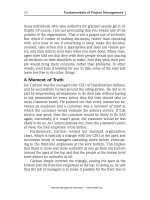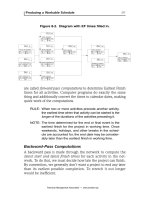Exploring management 6th by schermerhornch03
Bạn đang xem bản rút gọn của tài liệu. Xem và tải ngay bản đầy đủ của tài liệu tại đây (447.5 KB, 47 trang )
Exploring Management
John Schermerhorn, Jr. and Daniel G. Bachrach
Sixth Edition
Chapter 3
Ethics and Social Responsibility
"So if hearing that the CEO of Apple is gay can help
someone struggling to come to terms with who he or
she is, or bring comfort to anyone who feels alone,
or inspire people to insist on their equality, then it's
worth the trade-off with my own privacy.“
Tim Cook, CEO Apple, Inc.
Copyright ©2018 John Wiley & Sons, Inc.
2
Your Chapter 3 Takeaways
•
Understand how ethics and ethical behavior play out in the workplace. (3.1)
•
Know how to maintain high standards of ethical conduct. (3.2)
•
Identify when organizations are and are not acting in socially responsible ways. (3.3)
Copyright ©2018 John Wiley & Sons, Inc.
3
Takeaway 3.1 – answers to come
•Ethical behavior is values driven.
•Views differ on what constitutes moral behavior
•What is considered ethical can vary across cultures.
•Ethical dilemmas arise as tests of personal ethics and values.
•People have tendencies to rationalize unethical behaviors.
Copyright ©2018 John Wiley & Sons, Inc.
4
ethics in the workplace 3.1
Ethical Behavior
Ethics
• A code of moral principles that sets standards of good or bad, or right or wrong, in our
conduct.
Ethical Behavior
• That which is “right” or “good” in the context of governing moral code.
• Ethical behavior is value driven
Copyright ©2018 John Wiley & Sons, Inc.
5
ethics in the workplace 3.1
Values Driven
Values
• Broad beliefs about what is appropriate behavior
Terminal Values
• Preferences about desired end states
Instrumental Values
• Preferences regarding the means to desired ends
Copyright ©2018 John Wiley & Sons, Inc.
6
ETHICS IN THE WORKPLACE 3.1
The Most Common Unethical Acts by Managers include:
•
Verbal
•
Sexual
•
Racial harassment
•
Misuse of company property
•
Giving preferential treatment
Copyright ©2018 John Wiley & Sons, Inc.
7
ethics in the workplace 3.1
Views on Moral Behavior Differ
Moral Reasoning
•
Reasons for various ethical practices
Figure 3.1 How Do Alternative Moral Reasoning Approaches View Ethical Behavior?
Copyright ©2018 John Wiley & Sons, Inc.
8
ethics in the workplace 3.1
Moral Reasoning
Utilitarian View
• Which action delivers the most good to the largest amount of people?
Copyright ©2018 John Wiley & Sons, Inc.
9
ethics in the workplace 3.1
Moral Reasoning
Individualism View
• Which action is in our best interest in the long-term?
• Can be quite different from the best choice for the short term
Copyright ©2018 John Wiley & Sons, Inc.
10
ethics in the workplace 3.1
Moral Reasoning
Justice View
Procedural Justice
•
Rules are applied fairly
Distributive Justice
•
People are treated the
same regardless of
Interactional Justice
•
People are treated with
dignity and respect
personal characteristics
Copyright ©2018 John Wiley & Sons, Inc.
Commutative Justice
•
Transactions are fair and
everyone has access to the
same information
11
ethics in the workplace 3.1
Moral Reasoning
Moral Rights View
• Fundamental rights of all people are respected
Copyright ©2018 John Wiley & Sons, Inc.
112
ethics in the workplace 3.1
Moral Reasoning
Excerpt From Universal Declaration of Human Rights United Nations
•Article 1—All human beings are born free and equal in dignity and right
•Article 18—Everyone has the right to freedom of thought, conscience, and religion
•Article 19—Everyone has the right to freedom of opinion and expression
•Article 22—Everyone has the right to work, to free choice of employment, to just and favorable conditions of work
•Article 26—Everyone has the right to education
Copyright ©2018 John Wiley & Sons, Inc.
13
ethics in the workplace 3.1
Ethics Varies Across Cultures
Situation:
•
A 12-year-old boy is working in a garment factory in Bangladesh. He is the sole income
earner for his family. He often works 12-hour days and was once burned quite badly by a hot
iron. One day he is told he can’t work. His employer was given an ultimatum by the firm’s
major American customer – “No child workers if you want to keep our contracts.” The boy
says, “I don’t understand. I could do my job very well. My family needs the money.”
Copyright ©2018 John Wiley & Sons, Inc.
14
ethics in the workplace 3.1
Cultural Relativism and Moral Absolutism
• Cultural relativism justifies a decision if it conforms to local values, laws, and practices
• Moral absolutism justifies a decision only if it conforms to the ways of the home country.
Figure 3.2 How Do Cultural Relativism and Moral Absolutism Influence International Business Ethics?
Copyright ©2018 John Wiley & Sons, Inc.
15
ethics in the workplace 3.1
Ethical Dilemma
• A situation that, although offering potential benefits, is unethical.
• One of the most common ethical dilemmas occurs when a company’s culture
conflicts with an employee’s personal ethics.
Copyright ©2018 John Wiley & Sons, Inc.
16
ethics in the workplace 3.1
Common Examples of Unethical Behavior at Work
Copyright ©2018 John Wiley & Sons, Inc.
17
ethics in the workplace 3.1
Rationalizing Unethical Behavior
Four reasons:
People Have a Tendency to Rationalize Unethical Behavior
1.
“What I’m doing is not really illegal.”
2. “My behavior is in everyone’s best interests.”
3. “Nobody will ever know about it.”
4. “The Organization will stand behind me.”
Copyright ©2018 John Wiley & Sons, Inc.
18
ethics in the workplace 3.1
Study Guide for Takeaway 3.1
Rapid Review:
•Ethical behavior is that which is accepted as “good” or “right” as opposed to “bad” or “wrong.”
•The utilitarian, individualism, moral rights, and justice views offer different approaches to moral reasoning; each takes a different perspective of when and
how a behavior becomes ethical.
•Cultural relativism argues that no culture is ethically superior to any other; moral absolutism believes there are clear rights and wrongs that apply
universally, no matter where in the world one might be.
•An ethical dilemma occurs when one must decide whether to pursue a course of action that, although offering the potential for personal or organizational
gain, may be unethical.
•Ethical dilemmas faced by managers often involve conflicts with superiors, customers, and subordinates over requests that involve some form of
dishonesty.
•Common rationalizations for unethical behavior include believing the behavior is not illegal, is in everyone’s best interests, will never be noticed, or will be
supported by the organization.
Copyright ©2018 John Wiley & Sons, Inc.
19
ethics in the workplace 3.1
Study Guide for Takeaway 3.1
Questions for Discussion:
1.
2.
3.
For a manager, is any one of the moral reasoning approaches better than the others?
Will a belief in cultural relativism create inevitable ethics problems for international business
executives?
Are ethical dilemmas always problems, or can they be opportunities?
Copyright ©2018 John Wiley & Sons, Inc.
200
ethics in the workplace 3.1
Be Sure You Can… for Takeaway 3.1
•differentiate between legal behavior and ethical behavior
•differentiate between terminal and instrumental values and give examples of each
•list and explain four approaches to moral reasoning
•illustrate distributive, procedural, interactive, and commutative justice in organizations
•explain the positions of cultural relativism and moral absolutism in international business
ethics
•illustrate the types of ethical dilemmas common in the workplace
•explain how bad management can cause ethical dilemmas
•list four common rationalizations for unethical behavior
Copyright ©2018 John Wiley & Sons, Inc.
211
MAINTAINING HIGH STANDARDS 3.2
Takeaway 3.2 – answers to come
•
•
•
•
•
Personal character and moral development influence ethical conduct.
Managers as positive role models can inspire ethical conduct.
Training in ethical decision making may improve ethical conduct.
Protection of whistleblowers may encourage ethical conduct.
Formal codes of ethics set standards for ethical conduct
Copyright ©2018 John Wiley & Sons, Inc.
222
maintaining high standards of ethical conduct 3.2
Influence on Moral Development
Ethical Frameworks
•
Personal rules and strategies for making ethical decisions
Lawrence Kohlberg
•
Three levels of moral development
Figure 3.3 What are the Stages in Kohlberg’s Three Levels of Moral Development?
Copyright ©2018 John Wiley & Sons, Inc.
23
maintaining high standards of ethical conduct 3.2
Management Influence
Management Behavior
•
In order to have a positive impact on ethical conduct throughout an organization, those at the top must
walk the talk.
•
•
•
An Immoral managers chooses to behave unethically.
An Amoral manager fails to consider ethics
A Moral manager makes ethical behavior a personal goal.
Copyright ©2018 John Wiley & Sons, Inc.
24
maintaining high standards of ethical conduct 3.2
Ethics Training
Ethics Training
• Seeks to help people understand the ethical aspects of decision making and to incorporate
high ethical standards into their daily behavior.
• Training helps employees understand the corporate culture and expectations regarding
ethical behavior.
Copyright ©2018 John Wiley & Sons, Inc.
25









